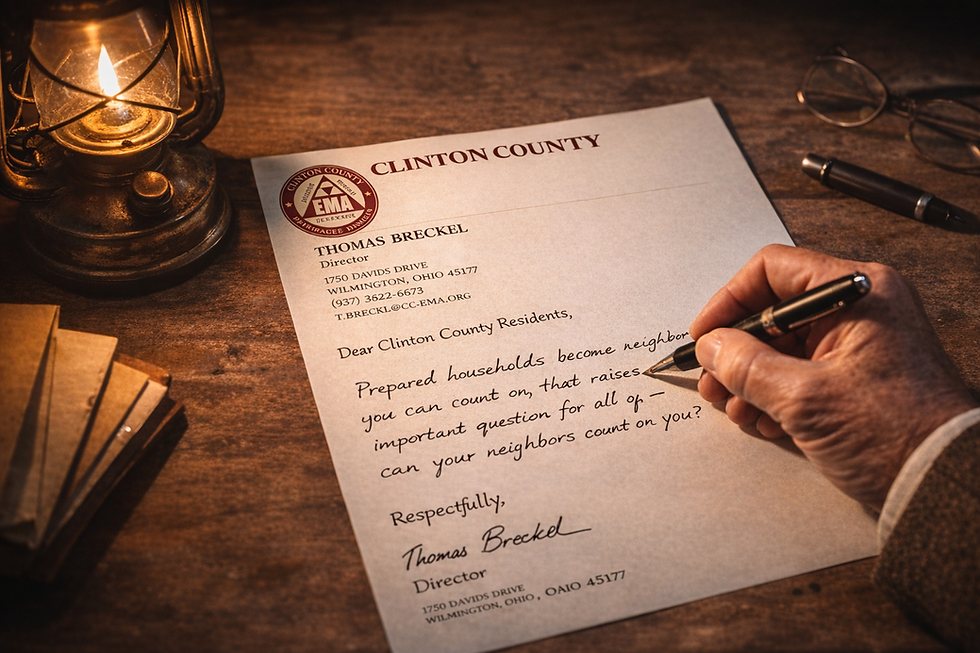Excessive Rainfall
- Thomas Breckel

- Mar 22, 2023
- 3 min read
If you are in an at-risk area for flooding (to include your basement), now is the time to prepare. Actions to consider listed at end of this post.
The National Weather Service has released a OnePager forecasting multiple rounds of rainfall that could result in local flooding in at-risk areas. Forecasted impact time for flooding late Friday night (24 March) and into early Saturday morning (25 March). The MODERATE threat for Clinton County indicates that there is a 40% chance that rainfall exceeding flash flood guidance will be within 25 miles of a given point.

The weather graph below contains forecast data starting at 12 Noon on Thursday and runs through Saturday 12 Noon. A substantial amount of rain is for forecasted for our area starting on Thursday afternoon and running into Saturday.

Actions to consider:
Know your risk for floods. Click the FEMA Flood Map Tool and enter your address to determine if your property may be at risk or in a Flood Zone. If you are in an at-risk area, then...
PREPARE before a Flood.
Consider purchase of Flood Insurance. Purchase or renew a flood insurance policy. Homeowner’s insurance policies do not cover flooding. It typically takes up to 30 days for a policy to go into effect so the time to buy is well before a disaster. Get flood coverage under the National Flood Insurance Program (NFIP).
Prepare for a flood. Make a plan for your household, including your pets, so that you and your family know what to do, where to go, and what you will need to protect yourselves from flooding. Learn and practice evacuation routes, shelter plans, and flash flood response. Gather supplies, including non-perishable foods, cleaning supplies, and water for several days, in case you must leave immediately or if services are cut off in your area.
In case of an emergency...Keep important documents in a waterproof container. Create password-protected digital copies. Protect your property. Move valuables to higher levels. Declutter drains and gutters. Install check valves. Consider a sump pump with a battery.
Staying Safe DURING a Flood.
Evacuate immediately, if told to evacuate. Never drive around barricades. Local responders use them to safely direct traffic out of flooded areas.
Contact your healthcare provider If you are sick and need medical attention. Wait for further care instructions and shelter in place, if possible. If you are experiencing a medical emergency, call 9-1-1.
Listen to EAS, NOAA Weather Radio or local alerting systems for current emergency information and instructions regarding flooding.
Do not walk, swim or drive through flood waters. Turn Around. Don’t Drown!
Stay off bridges over fast-moving water. Fast-moving water can wash bridges away without warning.
Stay inside in your car if it is trapped in rapidly moving water. Get on the roof if water is rising inside the car.
Get to the highest level if trapped in a building. Only get on the roof if necessary and once there signal for help. Do not climb into a closed attic to avoid getting trapped by rising floodwater.
Staying Safe DURING a Flood.
Pay attention to authorities for information and instructions. Return home only when authorities say it is safe.
Avoid driving except in emergencies.
Wear heavy work gloves, protective clothing and boots during clean up and use appropriate face coverings or masks if cleaning mold or other debris.
People with asthma and other lung conditions and/or immune suppression should not enter buildings with indoor water leaks or mold growth that can be seen or smelled. Children should not take part in disaster cleanup work.
Be aware that snakes and other animals may be in your house.
Be aware of the risk of electrocution. Do not touch electrical equipment if it is wet or if you are standing in water. Turn off the electricity to prevent electric shock if it is safe to do so.
Avoid wading in floodwater, which can be contaminated and contain dangerous debris. Underground or downed power lines can also electrically charge the water.
Use a generator or other gasoline-powered machinery ONLY outdoors and away from windows.
Otherwise:
Ensure your gutters are clear of debris.
Do not store property on the ground in basements or in at-risk flooding areas. Move to shelves or raised areas as much as possible. Temporarily bag items that are stored on the ground to keep dry.
Do not store plugged-in electrical items in areas at-risk for flooding. Temporarily unplug and store in a raised location. If item must remain plugged, adjust wiring path to an elevated option to keep from getting wet.
If you store documents or photo albums in your basement or in at-risk areas, it is best to keep them in a waterproof container for protection.
If your basement floods, start your clean-up as soon as possible. Mold can start to grow in as little as 24 to 48 hours. This includes retrieving damp possessions and begin drying them out as soon as possible.
Resources/Information:






Comments